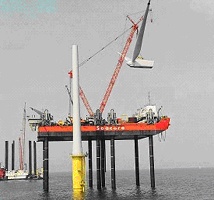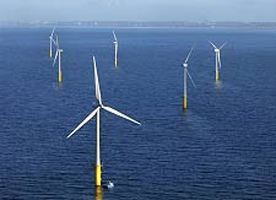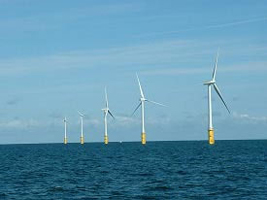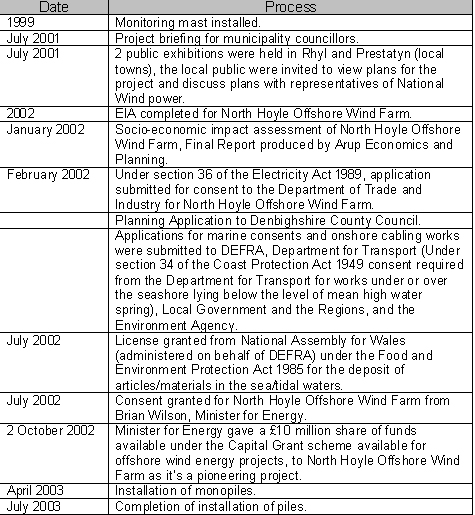 |
 |
 |
 |
 |
 |
 |
 |
 |
 |
 |
 |
Project description
Name of the case study
North Hoyle Offshore wind farm
Description of context
• The National Assembly for Wales has a legal duty to pursue sustainable development in all it does. This is built into its constitution through section 121 of the Government of Wales Act.
• Denbighshire Unitary Development Plan 1996-2011 includes the statement "To support, where practicable and appropriate, energy regeneration from renewable sources". (http://www.denbighshire.gov.uk/planningudp/english/chap2.htm)
• Denbighshire County Council is working to produce Supplementary (Planning) Guidance notes on Renewable Energy.
• The Denbighshire Objective One Partnerships Local Action Plan (LAP) European Local Action Plan (version 2003) provides a strategic framework and vision for an Objective 1 Programme to deliver economic regeneration and community development within the county. STO 5 of the LAP, deals with Protection and enhancement of the natural and built environment and states as one of its key drivers: "Sustainable development of the rural economy through support for rural tourism, access, conversion and renewable energy initiatives*quot; and lists as its targets: "Clean energy initiatives supported (and) clean energy plants supported".
• Additional supporting documents for wind energy are: policy documents from the National Assembly for Wales Technical Advice Note 8 (1996) Renewable Energy National Assembly for Wales and British Wind Energy Association (2002) Best Practice Guidelines: Consultation for Offshore Wind Energy Developments British Wind Energy Association (http://www.offshorewindfarms.co.uk).
Description of project - background
The North Hoyle Offshore Wind Farm development, located off the north Wales coast, will consist of 30 turbines that can generate 60 MW of electricity. This is equivalent to the demand of approximately 50,000 homes, or one third of all the homes in the 3 counties nearest to the wind farm (1.5% of electricity demand in Wales, UK).
National Wind Power, who is funding the development, are a UK company who generate and supply energy. National Wind Power is part of RWE Innogy that invest in all types of renewable sources of energy including wind power, hydro and biomass. National Windpower Ltd has developed 17 wind farms worldwide, including 13 in the UK with a capacity of 159 MW and 3 in the US with a capacity of 123 MW.

Installation of a wind turbine at North Hoyle off the coast of North Wales.
An in depth investigation was carried out to identify the most suitable location for the wind farm. The main factor for this is the availability of fuel resource, wind, which was monitored at the site for 2 years prior to development. Other reasons for the selection of North Hoyle as a suitable location are:
• Relatively low exposure to large waves from a predominant wind direction (SW/W);
• Relatively low water depth for the corresponding distance from shore;
• Good seabed properties for foundations and sub-sea cables;
• Strong electrical infrastructure near to the coast;
• Nearby port facilities suitable for construction and operations (Liverpool, Mostyn and Rhyl);
• No known environmental sensitivities.
The turbines at North Hoyle are positioned in a 6x5 layout, which has been assessed for visual appearance from the coast.

Overhead photograph of North Hoyle illustrating the layout of the turbines
Identifying a site to locate a wind farm includes:
1. identify site:
• From July 2004, the government was legally required by an EU directive to evaluate areas to identify where facilities can be located. The Wash, Thames Estuary and North West Coast were selected by the Government for Strategic Environmental Assessment (SEA).
• Investigative studies are required to look at wind resources as well as other characteristics of a site including biological, water depth, environmental sensitivities, bird populations, ground conditions, navigation, wiring and potential human impacts.
Information is compiled on a map to identify where fewest constraints are.
2. An Environmental Impact Assessment (EIA) is required by EU legislation if the site generates more than 50 MW in order to investigate biological and physical parameters.
3. Under the Town and Country Planning Act and the Electricity Act, application must be made for planning permission
4. Undertake community consultations with all potential stakeholders.

Wind turbines in operation at North Hoyle
A consortium of a Danish company Vestas Wind Systems (who supplied the turbines) and a British company Mayflower Energy, known as the North Hoyle Consortium (NHC), constructed the wind farm. NHC was contracted to install the wind turbines for North Hoyle including foundations, electrical infrastructure, remote monitoring system and servicing for 5 years. National Wind Power internally test and assess new turbine products for longevity, operation and physical aspects.
Description of project - objectives/aims
National Wind Power develops and operates wind farms and is therefore concerned with both capital and operational costs. Sustainability considerations are made for the projects lifetime including investment in waste management incorporating reuse and recycling wherever possible, avoiding the use of harmful chemicals and investigating life costs. The organisation also involves the local community to ensure minimum social impact.
Description of project - time interval and stages
The following table illustrates key dates throughout the development of the wind farm.

Description of project - financing
The project was funded by National Wind Power.
Description of project - other sectors involved
-
What tools were used to assess sustainability?
Countryside Council for Wales (CCW) Seascape Assessment
Environmental Impact Assessment (EIA);
Public participation including visual assessment (photo montage)
Socio-economic Impact Assessment (SEIA);
More information